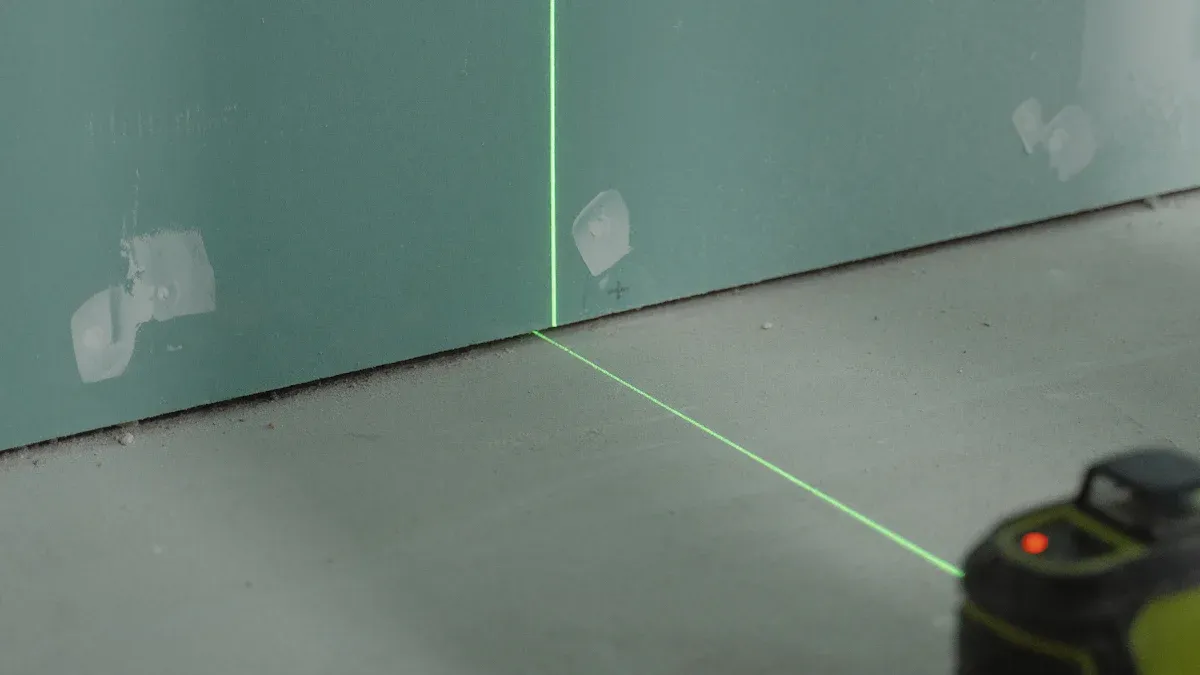
19 Jul 7 Best Materials to Replace Blue Gypsum Board This Year
Table of Contents
If you’re considering alternatives to blue gypsum board, there are several excellent materials to choose from, each offering unique advantages:
Cement Board: Remains durable in wet environments and resists mold, making it a solid substitute for blue gypsum board.
Fiber Cement Board: Highly durable and water-resistant, this option is a reliable replacement for blue gypsum board in moisture-prone areas.
Magnesium Board: Delivers fire resistance and long-lasting performance, making it a strong contender against blue gypsum board.
PVC Panels: These are easy to clean and ideal for damp spaces, serving as a practical alternative to blue gypsum board.
Paperless Drywall: Features a fiberglass finish that protects against mold, offering another way to move beyond traditional blue gypsum board.
Reclaimed Wood: An eco-friendly choice that adds warmth and character, while still serving as an alternative to blue gypsum board.
Plaster Base Board: Handles moisture effectively and is built to last, making it a dependable substitute for blue gypsum board.
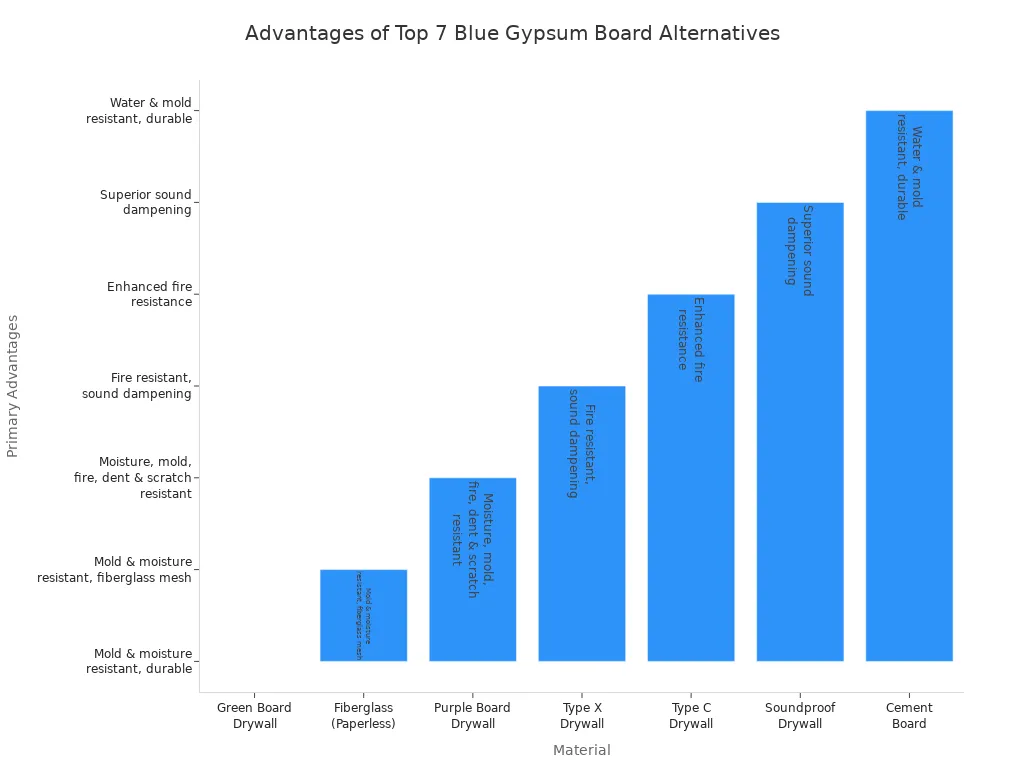
Consider the specific needs of your space—whether it’s a bathroom, kitchen, or basement—when choosing the best alternative to blue gypsum board for your project.
Key Takeaways
Cement board and fiber cement board are very strong. They do not get damaged by water. This makes them great for bathrooms and kitchens.
Magnesium board and plaster base board stop fires well. They are also very strong for a long time. These are good for places that need to be safe.
PVC panels and paperless drywall do not let mold grow. They are simple to clean. This helps rooms stay healthy and bright.
Reclaimed wood gives a special look. It is good for the environment. But it needs more work to use than other materials.
You should pick the best material for your space. Think about what you need, how much you can spend, and what features you want. Some features are moisture control, fire safety, or helping the environment.
1. Cement Board
Features
Cement board stands out for its strength and ability to handle moisture. You can use it in places where water is a problem, like bathrooms or kitchens. The board resists mold and mildew, which helps keep your walls healthy. Cement board does not break down easily, even when exposed to water. You will find it heavier and tougher than regular drywall. It comes in different thicknesses, so you can pick the right one for your project.
Cement board lasts a long time if you take care of it. In wet areas, it can last from 20 to 60 years, depending on where you use it and how well you maintain it. You should use waterproof membranes to protect it from too much moisture. Regular checks and repairs help prevent mold and damage.
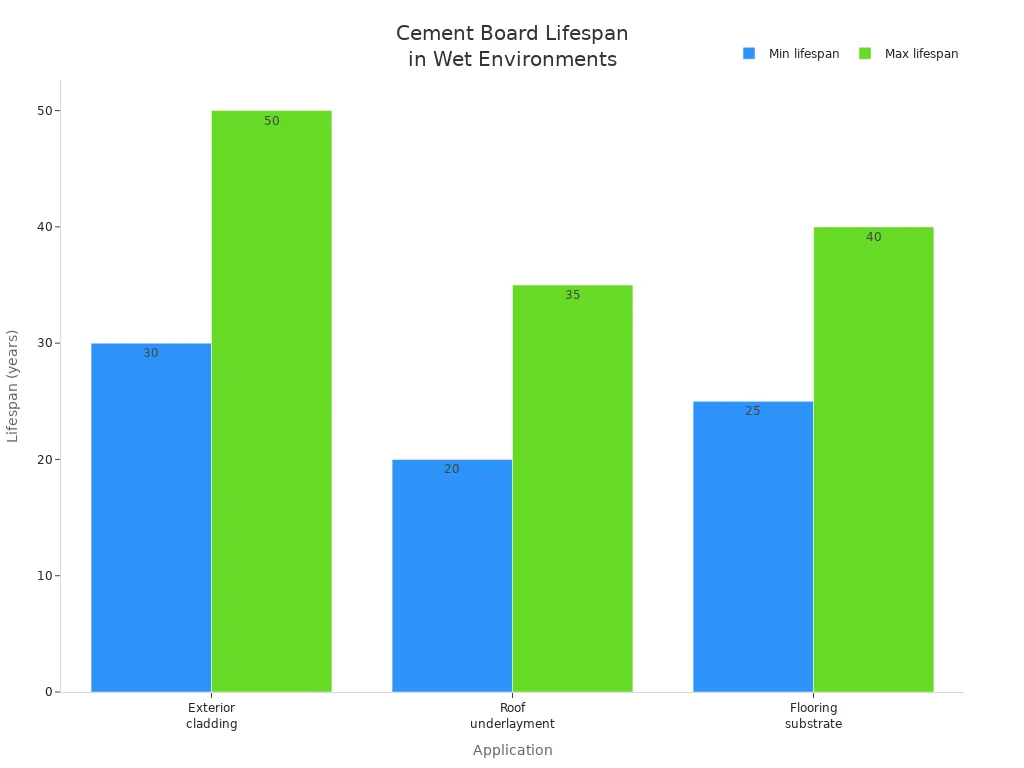
Pros and Cons
Pros:
Handles moisture and mold very well
Strong and durable for many years
Works great as a base for tile in wet rooms
Cons:
Heavier and harder to cut than drywall
Needs special tools for installation
Costs more than blue gypsum board
Needs extra waterproofing in very wet places
Best Uses
You can use cement board in many parts of your home or building. Here are some common uses:
Application Area | Description |
|---|---|
Interior Wet Areas (Kitchens, Baths) | Acts as a base for tile and protects against water damage |
Exterior Wall Cladding Systems | Supports stone, brick, or stucco on outside walls |
Masonry Veneer Wall Systems | Used in homes and low-rise buildings for added strength and water control |
Stucco Wall Systems | Provides a tough, moisture-resistant surface for stucco finishes |
Continuous Insulation | Adds an extra layer to keep heat in and moisture out |
Drainage Mat | Helps water drain away from walls to keep them dry |
Weather-Resistant Barrier (WRB) | Blocks water from getting inside while letting walls breathe |
Comparison
Cement board gives you better moisture resistance and strength than blue gypsum board. You will notice that cement board costs more and takes more effort to install. It is heavier and needs special tools, but it lasts longer in wet areas. Blue gypsum board is easier to handle and cheaper, but it does not hold up as well in places with lots of water. If you want a wall that stays strong and dry for many years, cement board is a smart choice, especially for bathrooms, kitchens, and outdoor walls.
2. Fiber Cement Board
Features
Fiber cement board is strong and reliable for walls. It is made from cement, sand, and cellulose fibers. This mix makes a hard panel that can handle tough weather. You can use fiber cement board in wet, hot, or cold places. It does not swell or crack when it gets wet. It also does not warp. The board is good at stopping fire and can take hard hits. Builders use fiber cement board in homes and big buildings.
Here is a table with the main features:
Performance Metric | Description and Details |
|---|---|
Density | High-density boards are stronger and harder (over 1,500 kg/m³). |
Fire Resistance | Meets fire safety codes; used for fire-rated walls in commercial buildings. |
Impact Strength | Resists cracking from heavy rain, strong winds, and extreme temperatures. |
Moisture Resistance | Does not absorb water, swell, or deteriorate; great for humid and coastal areas. |
Durability | Resists termites, rot, and mildew; needs little maintenance. |
Commercial Use | Preferred for large, high-traffic buildings due to strength and durability. |
Tip: Fiber cement board stays strong after years of snow, rain, and sun. It works best if you install it with good flashing and drainage.
Pros and Cons
Pros:
Handles wet, humid, and rough weather well
Lasts many years with little care
Stops fire, termites, and mildew
Good for inside and outside projects
Cons:
Heavier and harder to cut than drywall
Makes dust when cut, so wear safety gear
Needs special fasteners and sometimes extra support
Takes more time and skill to put in
Best Uses
Fiber cement board works well in tough places. Experts say to use it for:
Places with hurricanes (can handle strong winds)
Cold places with freeze and thaw cycles
Wildfire zones (does not burn)
Outside walls in places with lots of rain or snow
Note: High-density fiber cement boards are best for outside walls in bad weather. They do not warp or crack, so you save money on repairs.
Comparison
Fiber cement board is better than blue gypsum board for wet and rough places. It lasts longer in bad weather. But it is heavier and harder to put in. You need special tools and fasteners, and it takes more time. Blue gypsum board is lighter and easier for home projects, but it does not last as long in wet or rough spots. Fiber cement board is also more eco-friendly because it uses recycled materials and saves energy when made.
3. Magnesium Board
 Features
Features
Magnesium board is also called MgO board. It is strong and safe for building. This panel does not burn or melt in high heat. It also resists water and mold. Builders use it because it stays stable in wet places. It does not warp or rot. You can use it for walls, ceilings, and floors. The board is light, so it is easy to carry and install. It is lighter than cement board.
Magnesium board does not make harmful fumes in a fire. This makes it safer for homes and public buildings.
Here is a table that shows how magnesium board compares to other materials for fire resistance:
Property | MgO Boards | Plywood | Drywall (Gypsum Board) | Fiber Cement Boards | OSB (Oriented Strand Board) |
|---|---|---|---|---|---|
High (Non-combustible) | Low (Combustible) | Moderate (Fire-resistant coating) | High (Fire-resistant) | Low (Combustible) |
Pros and Cons
You should know the good and bad sides before you pick magnesium board.
Pros of Magnesium Board | Cons of Magnesium Board |
|---|---|
Great fire resistance | Can cost more than regular drywall |
Stops water, mold, and mildew | May need special fasteners |
Light and easy to use | Not always in every store |
Good for healthy indoor air | Some brands may be different in quality |
Best Uses
Magnesium board works in many projects. Here are some common uses:
Wall panels and ceilings in homes, schools, and hospitals
Flooring base and outside wall covers
Bathrooms, basements, and other wet places
Fire-safe walls in theaters, airports, and apartments
Subflooring and sheathing for strong buildings
Fast remodels and green building jobs
Magnesium board is great where you need fire safety and moisture control.
Comparison
Magnesium board is better than blue gypsum board for fire and water safety. It does not burn, even in very high heat. It stays strong in wet places like bathrooms or basements. Magnesium board is lighter than cement board. It is stronger than regular drywall. You might pay more and need special fasteners. But you get extra safety and strength. If you want a safe and long-lasting wall or ceiling, magnesium board is a smart pick.
4. PVC Panels
Features
PVC panels are a modern way to cover walls and ceilings. They are made from polyvinyl chloride, which is a type of plastic. This plastic does not let water or stains soak in. You can get PVC panels in many colors and patterns. It is easy to match them to your style. The panels fit together with special edges that lock in place. This makes them quick to put up. You only need a damp cloth to clean them. The surface of PVC panels is antibacterial. This helps stop mold and mildew from growing and keeps rooms healthy.
Tip: Use PVC panels if you want a clean and bright space. They are good for places where you need to keep out moisture.
Pros and Cons
Pros:
They are light and simple to move.
You can put them up fast because of the design.
They do not let water in and are easy to wipe clean.
The surface helps stop mold from growing.
There are lots of styles for any room.
Cons:
They do not break down in nature, so they last in landfills.
Some panels can let out chemicals that may not be safe.
If you do not install them well, they can wear out or fade in the sun.
You might need to check and fix them if water does not drain right.
PVC panels can last for many years if you put them in the right way. But if you do not, water can leak in or cause damage. You should check drains often to stop water from building up.
Best Uses
You can use PVC panels in many rooms:
Kitchens and bathrooms where there is a lot of water
Living rooms and bedrooms for a new look
Stores, restaurants, and offices because they are easy to clean
Hospitals and schools where it is important to keep things clean
Experts say PVC panels are best where you need strong, safe, and easy-to-clean walls. You can also get panels that slow fire or block sound if you need them.
Comparison
Aspect | PVC Panels | Blue Gypsum Board |
|---|---|---|
Material Cost | A little more expensive | |
Installation Labor | Lower, easy for DIY | Higher, needs skilled installers |
Installation Time | Shorter, quick interlocking panels | Longer, more steps required |
Maintenance | Easy to clean, needs regular checks | Needs less frequent cleaning |
Environmental Impact | Not biodegradable, recycling helps | More eco-friendly |
PVC panels are faster and cheaper to put up than blue gypsum board. You can do it yourself with simple tools. But blue gypsum board is better for the earth and sometimes lasts longer.
5. Paperless Drywall
Features
Paperless drywall has fiberglass mesh on the outside instead of paper. This mesh helps stop water and mold from getting in. The surface feels different than regular drywall but is still smooth. You can paint or put tiles on it easily. Builders like to use paperless drywall in wet places. For example, M2Tech Shaftliner Type X is a well-known paperless drywall. It got a top score of 10 for mold resistance in ASTM D3273 tests. This means it protects very well against mold, even if it gets wet.
Fiberglass mesh is used instead of paper
It resists mold and water much better than regular drywall
The surface is ready for paint or tile
Tip: Use paperless drywall where you worry about water or mold.
Pros and Cons
Contractors talk about good and bad things with paperless drywall. Here is a quick list:
Advantages | Disadvantages |
|---|---|
Fiberglass keeps water out | Needs careful work to finish the surface |
Panels are light and quick to put up | Makes dust when you install it |
Gypsum core helps stop fire | Needs skill for joints and finishing |
Easy to cut and fix | Costs a bit more than regular drywall |
Walls and ceilings look smooth | Not always easy to find in every store |
Many contractors say paperless drywall fixes water problems that regular drywall cannot.
Best Uses
Use paperless drywall where water might be a problem. Builders say it is good for:
Bathrooms and kitchens
Basements and laundry rooms
Garages and utility rooms
Near woodstoves for extra heat safety
It also helps walls last longer because it does not dent or scratch easily. Many builders use it in whole bathrooms and kitchens, except for ceilings, to stop water damage.
Comparison
Paperless drywall is better than regular drywall for stopping mold and water. It works well where blue gypsum board might not last. It is easier to put up than cement board, but you must finish it carefully. It costs a little more, but you get better protection and longer-lasting walls. If you want a strong wall for wet places, paperless drywall is a good choice.
6. Reclaimed Wood
Features
Reclaimed wood is a special and earth-friendly way to finish walls. This wood comes from old buildings, bridges, or even trees under water. Every piece of reclaimed wood looks different and has its own story. You can get reclaimed wood from many places. Old buildings and bridges give wood a rough, real look. Manufacturing scraps help keep trash out of landfills. Some wood comes from trees pulled out of lakes or rivers, so no new trees are cut. Orchard trees are used when they get too old and would be thrown away. Small trees left on the forest floor after logging can also be used again. Picking reclaimed wood helps cut down on waste and supports green design. Many sellers have wood with FSC or SFI labels, so you know it is from good sources. Always check for nails, screws, or damage before using reclaimed wood.
Pros and Cons
There are good things and hard things about using reclaimed wood:
Pros:
Helps the planet and saves trees 🌳
Makes your space warm and full of history
Can be stronger than new wood
Supports green building
Cons:
Each piece is different, so check them all
Needs extra cleaning or drying before use
Sometimes needs special rules to be used in buildings
Tip: Buy from trusted sellers to get safe, ready-to-use wood for your project.
Best Uses
You can use reclaimed wood in many fun ways at home or work. It is great for wall panels and feature walls that add texture. Use it for floors to make rooms feel cozy and old-fashioned. Make custom furniture, cabinets, or doors that look special. Try it for shelves, mantels, counters, or headboards as cool accents. Reclaimed wood fits both new and old styles. It works in living rooms, bedrooms, offices, and restaurants.
Comparison
Reclaimed wood is great for the earth and has a one-of-a-kind look. It saves resources and gives your space a special feel. But you will spend more time getting reclaimed wood ready than blue gypsum board. You must clean, smooth, and sometimes dry the wood before using it. This makes the job harder and often costs more. Blue gypsum board is faster and cheaper to put up, but it does not have the same warmth or green benefits. If you want an earth-friendly choice with lots of style, reclaimed wood is a great pick.
7. Plaster Base Board
Features
Plaster base board is also called “blue board.” It gives a strong and smooth wall for plaster. This board does not let mold or water in. Many brands get a top score for stopping mold. The board does not crack or break easily. Nails do not pop out, and it can take hits. You can buy it in two thicknesses: 1/2″ and 5/8″. The edges are shaped to make seams easy to finish. Some brands use recycled paper and have GREENGUARD Gold Certification. This means the board helps keep your air clean.
Performance Characteristic | Details |
|---|---|
Moisture Resistance | |
Durability | High resistance to cracking, impact, and abrasion |
Fire Resistance | Noncombustible core, meets ASTM E136, low flame and smoke ratings |
Physical Properties | 1/2″ or 5/8″ thick, 1.7–2.1 lbs/sq.ft., tapered edges |
Additional Features | High-suction face paper, GREENGUARD Gold Certification |
Plaster base board is a good choice for walls that last a long time and look nice.
Pros and Cons
There are good things and some problems with plaster base board.
Pros | Cons |
|---|---|
Makes walls strong, smooth, and classic | Needs more work and skilled workers |
Can last longer than the house | Can crack if the building moves |
Stops mold and fire very well | |
Costs more than other boards | |
Paint looks better and you can add cool textures | Thick walls can make Wi-Fi weaker |
Best Uses
Plaster base board works well in many places:
Old homes or buildings with curved or fancy walls
Bathrooms and kitchens where it gets wet
Rooms where you want quiet, like bedrooms or offices
Schools, hospitals, or big buildings that need fire safety
Tip: Pick plaster base board if you want walls that fight water, fire, and daily bumps.
Comparison
Plaster base board is great at stopping water, mold, and fire. It is harder and smoother than regular drywall. You need more skill and time to put it up. But you do not need to sand or add many coats, so you finish faster. The surface does not dent or scratch easily, so it is easy to keep nice. If you need to fix it, you must know how to use plaster. Plaster base board costs more and is not as easy to find. But it gives you a fancy wall that lasts for many years.
Blue Gypsum Board vs Alternatives
 Quick Comparison Table
Quick Comparison Table
It is important to pick the right wall material. The table below lets you see how blue gypsum board and seven other materials compare. You can check how each one does with water, strength, fire, price, and where to use it.
Material | Moisture Resistance | Durability | Fire Resistance | Cost (per 4×8 panel) | Best Uses |
|---|---|---|---|---|---|
Blue Gypsum Board | High | Durable in moist areas | Moderate | Bathrooms, moist areas, noise reduction | |
Cement Board | Very High | Very Rigid | Low | $15 – $20 | Showers, baths, tile base |
Fiber Cement Board | Very High | Long-lasting | High | $18 – $25 | Exteriors, wet/humid areas |
Magnesium Board | High | Strong, lightweight | Very High | $20 – $30 | Fire-safe, wet areas, ceilings |
PVC Panels | Very High | Moderate | Low | $10 – $18 | Kitchens, bathrooms, easy-clean spaces |
Paperless Drywall | Very High | Tougher than drywall | Moderate | $25 – $35 | Bathrooms, mold-prone rooms |
Reclaimed Wood | Moderate | Varies (can be high) | Low | $20 – $40+ | Accent walls, eco-friendly projects |
Plaster Base Board | High | Very Durable | High | $18 – $28 | Historic homes, wet areas, fire safety |
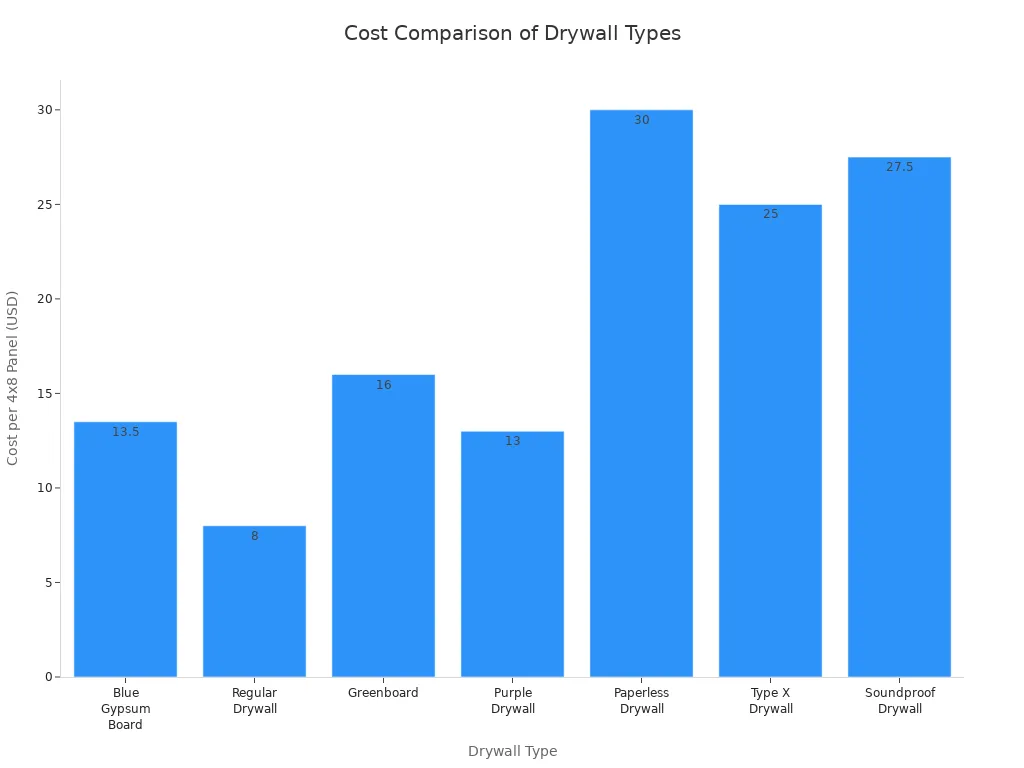
Tip: Think about what your room needs before you choose. Some materials are better for wet places. Others are best if you want fire safety or to help the planet.
Key Differences
Moisture Resistance
If you want the best wall for wet spots, cement board, fiber cement board, PVC panels, and paperless drywall are better than blue gypsum board. These work great in bathrooms, kitchens, and basements.Durability
Fiber cement board and plaster base board last the longest. Cement board is also very strong. Blue gypsum board is good in damp places but not as tough as these.Fire Resistance
Magnesium board and plaster base board are best for fire safety. Fiber cement board also helps protect against fire. Pick these for garages, kitchens, or any place where fire is a worry.Cost
PVC panels and blue gypsum board cost the least. Paperless drywall and reclaimed wood are more expensive but give you special things like mold protection or being green.Best Uses
For bathrooms and showers: Cement board, PVC panels, and paperless drywall are top picks.
For kitchens: Fiber cement board, PVC panels, and blue gypsum board work well.
For basements: Magnesium board and paperless drywall help stop mold.
For accent walls or green projects: Reclaimed wood gives style and helps the earth.
For fire safety: Magnesium board and plaster base board keep you safer.
You can find the best material for your job by looking at these points. This helps you get strong, safe, and lasting walls for your home or building.
You have many options when you want to replace blue gypsum board. Each material offers different strengths.
Cement board and fiber cement board work best in wet areas.
Magnesium board and plaster base board give you extra fire safety.
PVC panels and paperless drywall help stop mold.
Reclaimed wood adds style and helps the planet.
Choose the material that fits your space, budget, and needs. For big projects or special rooms, talk to a building expert.
FAQ
What is the best material for a bathroom wall?
You should use cement board or PVC panels in bathrooms. Both resist water and mold. Cement board works well behind tiles. PVC panels clean easily and install quickly.
Can I install these materials myself?
You can install PVC panels and paperless drywall with basic tools. Cement board and fiber cement board need special tools and skills. For magnesium board or plaster base board, you may want professional help.
Are these alternatives safe for people with allergies?
Yes, most options like paperless drywall, magnesium board, and PVC panels resist mold and mildew. These choices help keep indoor air cleaner and safer for people with allergies.
How do I choose the right material for my project?
Think about where you will use the material. For wet areas, pick cement board or PVC panels. For fire safety, choose magnesium board. For eco-friendly projects, reclaimed wood works best.
Do these materials cost more than blue gypsum board?
Some alternatives, like cement board and magnesium board, cost more. PVC panels and blue gypsum board are usually cheaper. You may pay more for better durability or special features.

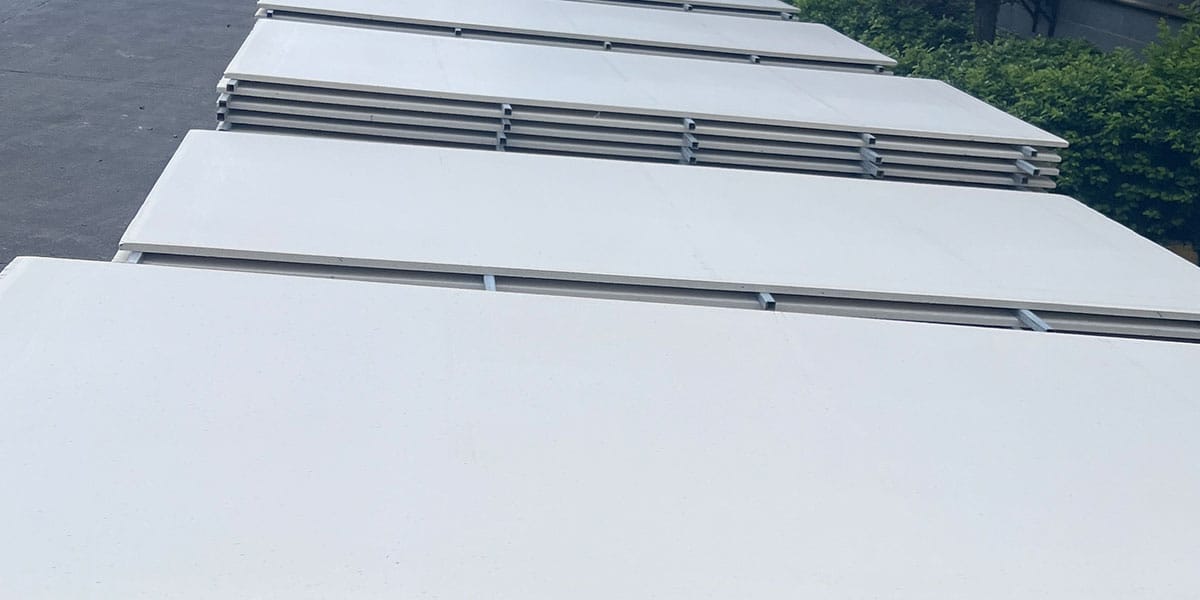 Features
Features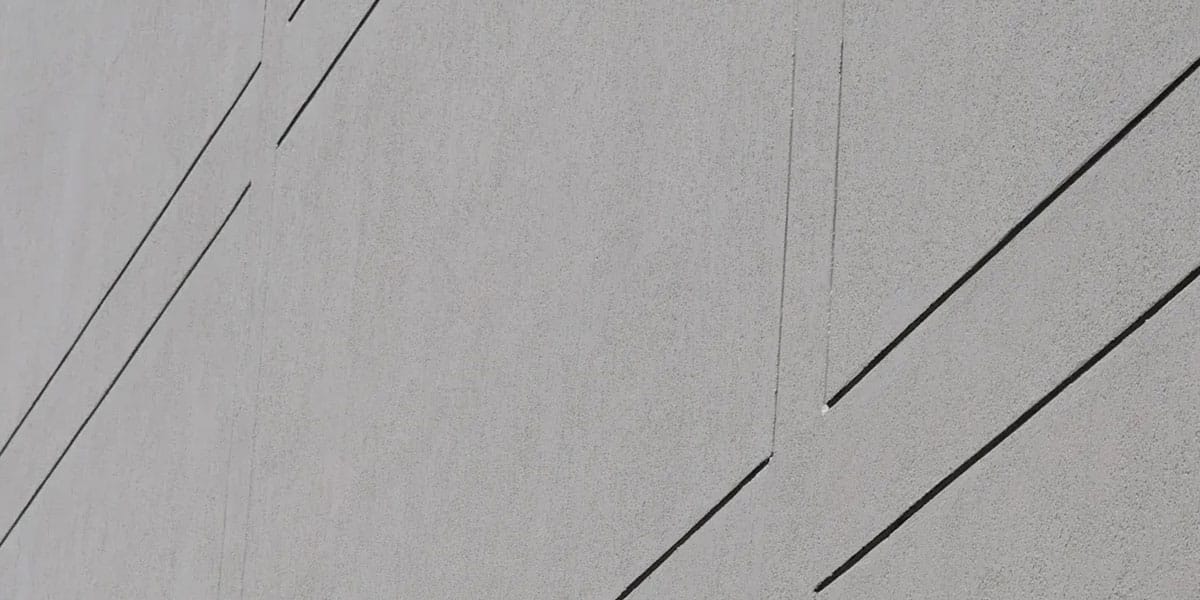 Quick Comparison Table
Quick Comparison Table